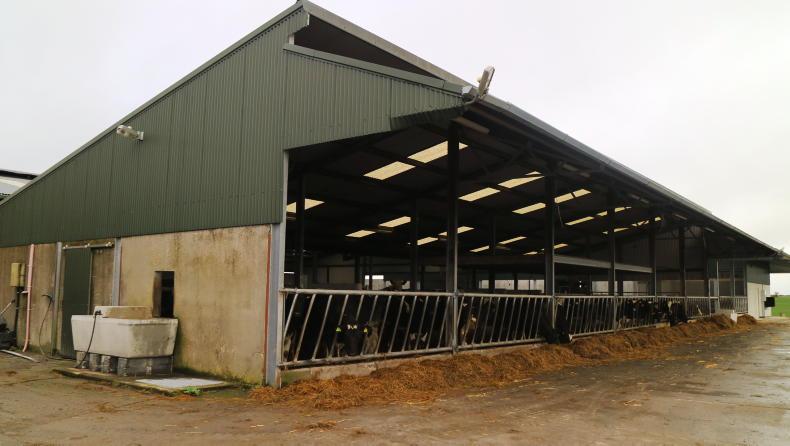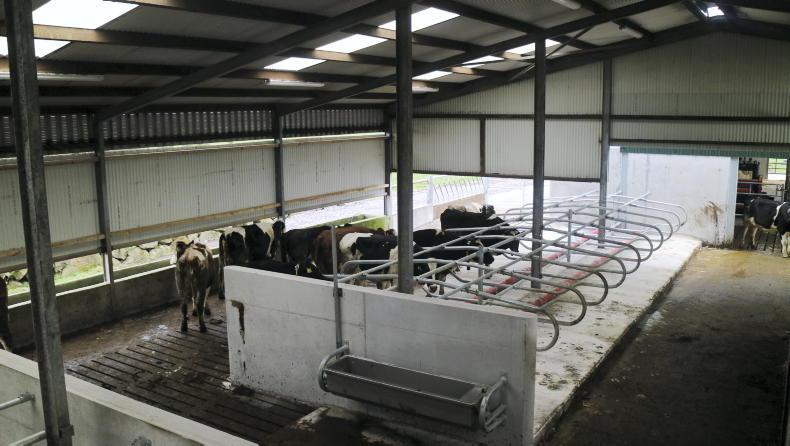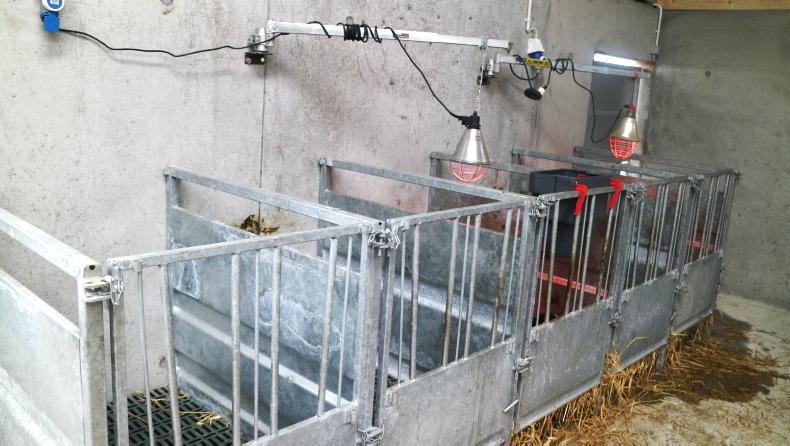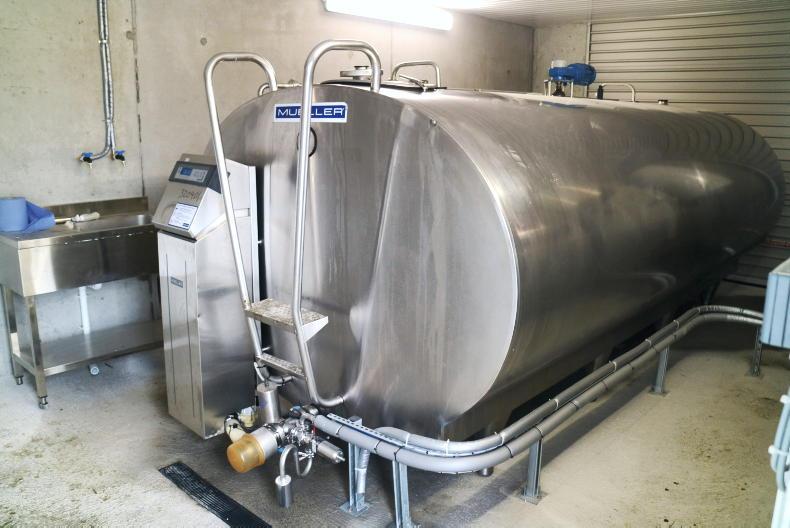Farming outside Corrandulla village in north Galway, Derrick Forde is a well-regarded breeder in the commercial and pedigree show cattle circuits.
It is one of these beef yards that formerly housed some of the 150 suckler cows that Derrick has converted to house the 70 heifers that were purchased last year for his new dairy enterprise.
The two six-bay double sheds held a mixture of slatted and bedded accommodation, as well as a central handling unit. A huge retrofit has now seen these sheds converted over to dairy accommodation.
From sucklers to cubicles
The original sheds comprise two six-bay doubles, with slatted tanks running along each side and external feeding. At the back of each tank was a large lieback/creep area, with the two liebacks split by a central handling unit. One of the sheds was built in 2016, which included the roofing over of the previously outdoor handling area.
The total width of the sheds, including the feed passage overhangs, came to 28m. Work began relatively late in the year, with the in-calf heifers happily out wintered on kale.
Derrick began gutting the internal layout of the shed in October. Nearly all internal walls and gates were removed, bar for the handling unit.
One side of the shed had a 12ft 6in slat with rubbers fitted to it, which Derrick removed and sold in favour of fitting new concrete slats with a gripped surface.
The two tanks were then linked up by fitting two slurry channels, one at each end of the shed.
Cubicle bases were poured, with Derrick opting for concrete end walls to allow for the shed to be split in spring between freshly calved cows and springers. In one of the original beef sheds there are 44 cubicles, with 41 cubicles in the other and an additional five cubicles in the drafting area off the robot. Derrick installed all Condon equipment, with the Condon adjustable cantilever cubicles, mats and brisket boards sourced from Paddy Fitzgerald Agri Supplies, Shrule, Co Mayo.
Slurry and calving facilities
Derrick left the external feed barriers and bunkers in place as they were all still in good working order. In addition, he repurposed a lot of the suckler gates to work for the layout of the new dairy unit.
The two existing slurry tanks have approximately 560m2, or 123,000 gallons, of storage between them, giving 18 weeks of storage for 78 cows, including a 20% buffer margin.

A 322m2 slurry tank was installed in the new shed in front of the Lely robot.
Originally, Derrick had intended to use part of the new shed as his calving facilities, which was adjoined to the robot area. However, a dry bedded area running alongside the handling crush has been working well for him.
Cows which Derrick expects to calve are easily drafted each night from the cubicle area in to a large communal dry-bedded pen. A single individual calving box, fitted with a calving gate, is available should a heifer require assistance.
After a cow calves, Derrick runs her through the handling unit, where her udder is clipped of hair for the robot and she receives her collar, with the calf transported to the new shed and placed inside an individual box.

A communal calving area has been created between the cubicles and handling chute.
Derrick has thought heavily about whether he would install an automatic milking system (AMS) or a conventional parlour.
“When I priced a parlour, with all the spec that I was getting from the robot, there was very little difference in price,’’ explained Derrick.

Originally intended for a calving area, this aer is being used for calf accomodation dur to it's proximity to the bulk tank.
The flexibility that the robot afforded Derrick, with his wife, Debbie, being able to use the machine, proved a major draw towards an AMS.
After exploring all options, Derrick decided to go with a Lely Astronaut A5 milking machine, complemented by a Lely Grazeway. A new four-bay building, measuring 20.55m long by 22.6m wide covers a new slatted tank that services the Lely Astronaut A5 machine.

Derrick has successfully converted two former beef suckler sheds to high-spec dairy accommodation.
The tank has 322m³ of storage and is fitted with 15ft 6in gripped slats and two external agitation points, with a Lely Luna brush fitted for cow comfort.

Derrick is able to subdivide the accomodation,with this area beside the robot being used for fresh calved heifers.
The building houses the robot room, office, toilet and bulk tank room, while to the rear of the Lely robot, there is a large dry-bedded area.

Cubicles were installed in the creep area of this shed. The loft area seen over the slats previously stored straw
This was originally to be used for a calving, calf nursery area, but the dry-bedded area beside the handling unit is working well.

Real-time information is provided on the display screen of the Lely Astronaut regarding milk yield.
With calves in close proximity to the robot, Derrick intends housing them here in this area to avoid drawing milk long distances, with additional accommodation available in another yard for overflow if required.
At the time of the Irish Farmers Journal’s visit, 15 of the maiden heifers had calved down and were passing through the robot.
Derrick noted that heifers were transitioning well to the machine, with some heifers being trained in one-two days.
.jpg)
Derrick had divided the accommodation to keep the calved heifers away from the in-calf ones, while a small isolation area containing six cubicles and a feed barrier is now being used to funnel any difficult heifers in to the robot until they present themselves.
Derrick is awaiting a Lely Discovery 120 Collector, a manure robot that services both solid and slatted floors.
The slurry channels between the two tanks were created with the Discovery in mind.

Slurry channels were created lining the two exisiting slurry tanks, with a Lely Discovery scraper ordered.
A Lely Grazeway, with a three-way drafting option, has been installed outside the new dairy building.

A Lley Luna cow brush was installed in the loafing area surrounding the milking robot.
Having viewed Grazeway gates on other farms, Derrick opted to install his unit on a slatted tank, again with gripped surface slats used.
The Grazeway remains untested, with Derrick hoping to get water troughs plumbed and fences set up in the next few weeks.
To retrofit the old sheds into suitable dairy accommodation, as well as build the new shed that holds the Lely robot, calf/calving area, office and the tanks both inside and outside the new shed, Derrick estimates the cost to be in the region of €120,000 plus VAT.
The new shed itself cost €35,000 plus VAT, sourced from Halcon Steel, Tuam, Co Galway, with the remaining works consisting of installing new slats, pouring of new tanks and floors and the new cubicle beds and associated cubicle fittings. Concrete and slats are sourced from Harrington Quarries,
In today’s climate, the unit proves good value for money, although the ability of Derrick to complete a good deal of the work himself alongside local contractor John Fitz Construction, as well as the large volume of slurry storage that was already in place, significantly contribute to the lower cost of completion of the works.

Calves are placed in individual boxes after birth. Derrick has created a swing over arm for the infra red lamb so it can service three boxes.

An 8,000l Mueller tank was installed as part of the build.

Colostrum is automatically sent from the robot to these buckets for feeding to calves.
Farming outside Corrandulla village in north Galway, Derrick Forde is a well-regarded breeder in the commercial and pedigree show cattle circuits.
It is one of these beef yards that formerly housed some of the 150 suckler cows that Derrick has converted to house the 70 heifers that were purchased last year for his new dairy enterprise.
The two six-bay double sheds held a mixture of slatted and bedded accommodation, as well as a central handling unit. A huge retrofit has now seen these sheds converted over to dairy accommodation.
From sucklers to cubicles
The original sheds comprise two six-bay doubles, with slatted tanks running along each side and external feeding. At the back of each tank was a large lieback/creep area, with the two liebacks split by a central handling unit. One of the sheds was built in 2016, which included the roofing over of the previously outdoor handling area.
The total width of the sheds, including the feed passage overhangs, came to 28m. Work began relatively late in the year, with the in-calf heifers happily out wintered on kale.
Derrick began gutting the internal layout of the shed in October. Nearly all internal walls and gates were removed, bar for the handling unit.
One side of the shed had a 12ft 6in slat with rubbers fitted to it, which Derrick removed and sold in favour of fitting new concrete slats with a gripped surface.
The two tanks were then linked up by fitting two slurry channels, one at each end of the shed.
Cubicle bases were poured, with Derrick opting for concrete end walls to allow for the shed to be split in spring between freshly calved cows and springers. In one of the original beef sheds there are 44 cubicles, with 41 cubicles in the other and an additional five cubicles in the drafting area off the robot. Derrick installed all Condon equipment, with the Condon adjustable cantilever cubicles, mats and brisket boards sourced from Paddy Fitzgerald Agri Supplies, Shrule, Co Mayo.
Slurry and calving facilities
Derrick left the external feed barriers and bunkers in place as they were all still in good working order. In addition, he repurposed a lot of the suckler gates to work for the layout of the new dairy unit.
The two existing slurry tanks have approximately 560m2, or 123,000 gallons, of storage between them, giving 18 weeks of storage for 78 cows, including a 20% buffer margin.

A 322m2 slurry tank was installed in the new shed in front of the Lely robot.
Originally, Derrick had intended to use part of the new shed as his calving facilities, which was adjoined to the robot area. However, a dry bedded area running alongside the handling crush has been working well for him.
Cows which Derrick expects to calve are easily drafted each night from the cubicle area in to a large communal dry-bedded pen. A single individual calving box, fitted with a calving gate, is available should a heifer require assistance.
After a cow calves, Derrick runs her through the handling unit, where her udder is clipped of hair for the robot and she receives her collar, with the calf transported to the new shed and placed inside an individual box.

A communal calving area has been created between the cubicles and handling chute.
Derrick has thought heavily about whether he would install an automatic milking system (AMS) or a conventional parlour.
“When I priced a parlour, with all the spec that I was getting from the robot, there was very little difference in price,’’ explained Derrick.

Originally intended for a calving area, this aer is being used for calf accomodation dur to it's proximity to the bulk tank.
The flexibility that the robot afforded Derrick, with his wife, Debbie, being able to use the machine, proved a major draw towards an AMS.
After exploring all options, Derrick decided to go with a Lely Astronaut A5 milking machine, complemented by a Lely Grazeway. A new four-bay building, measuring 20.55m long by 22.6m wide covers a new slatted tank that services the Lely Astronaut A5 machine.

Derrick has successfully converted two former beef suckler sheds to high-spec dairy accommodation.
The tank has 322m³ of storage and is fitted with 15ft 6in gripped slats and two external agitation points, with a Lely Luna brush fitted for cow comfort.

Derrick is able to subdivide the accomodation,with this area beside the robot being used for fresh calved heifers.
The building houses the robot room, office, toilet and bulk tank room, while to the rear of the Lely robot, there is a large dry-bedded area.

Cubicles were installed in the creep area of this shed. The loft area seen over the slats previously stored straw
This was originally to be used for a calving, calf nursery area, but the dry-bedded area beside the handling unit is working well.

Real-time information is provided on the display screen of the Lely Astronaut regarding milk yield.
With calves in close proximity to the robot, Derrick intends housing them here in this area to avoid drawing milk long distances, with additional accommodation available in another yard for overflow if required.
At the time of the Irish Farmers Journal’s visit, 15 of the maiden heifers had calved down and were passing through the robot.
Derrick noted that heifers were transitioning well to the machine, with some heifers being trained in one-two days.
.jpg)
Derrick had divided the accommodation to keep the calved heifers away from the in-calf ones, while a small isolation area containing six cubicles and a feed barrier is now being used to funnel any difficult heifers in to the robot until they present themselves.
Derrick is awaiting a Lely Discovery 120 Collector, a manure robot that services both solid and slatted floors.
The slurry channels between the two tanks were created with the Discovery in mind.

Slurry channels were created lining the two exisiting slurry tanks, with a Lely Discovery scraper ordered.
A Lely Grazeway, with a three-way drafting option, has been installed outside the new dairy building.

A Lley Luna cow brush was installed in the loafing area surrounding the milking robot.
Having viewed Grazeway gates on other farms, Derrick opted to install his unit on a slatted tank, again with gripped surface slats used.
The Grazeway remains untested, with Derrick hoping to get water troughs plumbed and fences set up in the next few weeks.
To retrofit the old sheds into suitable dairy accommodation, as well as build the new shed that holds the Lely robot, calf/calving area, office and the tanks both inside and outside the new shed, Derrick estimates the cost to be in the region of €120,000 plus VAT.
The new shed itself cost €35,000 plus VAT, sourced from Halcon Steel, Tuam, Co Galway, with the remaining works consisting of installing new slats, pouring of new tanks and floors and the new cubicle beds and associated cubicle fittings. Concrete and slats are sourced from Harrington Quarries,
In today’s climate, the unit proves good value for money, although the ability of Derrick to complete a good deal of the work himself alongside local contractor John Fitz Construction, as well as the large volume of slurry storage that was already in place, significantly contribute to the lower cost of completion of the works.

Calves are placed in individual boxes after birth. Derrick has created a swing over arm for the infra red lamb so it can service three boxes.

An 8,000l Mueller tank was installed as part of the build.

Colostrum is automatically sent from the robot to these buckets for feeding to calves.







.jpg)















SHARING OPTIONS